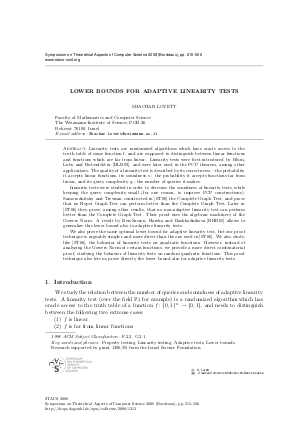Lower bounds for adaptive linearity tests
Author Shachar Lovett
-
Part of:
Volume:
25th International Symposium on Theoretical Aspects of Computer Science (STACS 2008)
Part of: Series: Leibniz International Proceedings in Informatics (LIPIcs)
Part of: Conference: Symposium on Theoretical Aspects of Computer Science (STACS) - License:
 Creative Commons Attribution-NoDerivs 3.0 Unported license
Creative Commons Attribution-NoDerivs 3.0 Unported license
- Publication Date: 2008-02-06
File

PDF
LIPIcs.STACS.2008.1313.pdf
- Filesize: 166 kB
- 12 pages
Document Identifiers
Subject Classification
Keywords
- Property testing
- Linearity testing
- Adaptive tests
- Lower Property testing
- Linearity testing
- Adaptive tests
- Lower
Metrics
- Access Statistics
-
Total Accesses (updated on a weekly basis)
0Document
0Metadata
Abstract
Linearity tests are randomized algorithms which have oracle access to the truth table of some function f, and are supposed to distinguish between linear functions and functions which are far from linear. Linearity tests were first introduced by (Blum, Luby and Rubenfeld, 1993), and were later used in the PCP theorem, among other applications. The quality of a linearity test is described by its correctness c - the probability it accepts linear functions, its soundness s - the probability it accepts functions far from linear, and its query complexity q - the number of queries it makes. Linearity tests were studied in order to decrease the soundness of linearity tests, while keeping the query complexity small (for one reason, to improve PCP constructions). Samorodnitsky and Trevisan (Samorodnitsky and Trevisan 2000) constructed the Complete Graph Test, and prove that no Hyper Graph Test can perform better than the Complete Graph Test. Later in (Samorodnitsky and Trevisan 2006) they prove, among other results, that no non-adaptive linearity test can perform better than the Complete Graph Test. Their proof uses the algebraic machinery of the Gowers Norm. A result by (Ben-Sasson, Harsha and Raskhodnikova 2005) allows to generalize this lower bound also to adaptive linearity tests. We also prove the same optimal lower bound for adaptive linearity test, but our proof technique is arguably simpler and more direct than the one used in (Samorodnitsky and Trevisan 2006). We also study, like (Samorodnitsky and Trevisan 2006), the behavior of linearity tests on quadratic functions. However, instead of analyzing the Gowers Norm of certain functions, we provide a more direct combinatorial proof, studying the behavior of linearity tests on random quadratic functions. This proof technique also lets us prove directly the lower bound also for adaptive linearity tests.
Cite As Get BibTex
Shachar Lovett. Lower bounds for adaptive linearity tests. In 25th International Symposium on Theoretical Aspects of Computer Science. Leibniz International Proceedings in Informatics (LIPIcs), Volume 1, pp. 515-526, Schloss Dagstuhl – Leibniz-Zentrum für Informatik (2008)
https://doi.org/10.4230/LIPIcs.STACS.2008.1313
BibTex
@InProceedings{lovett:LIPIcs.STACS.2008.1313,
author = {Lovett, Shachar},
title = {{Lower bounds for adaptive linearity tests}},
booktitle = {25th International Symposium on Theoretical Aspects of Computer Science},
pages = {515--526},
series = {Leibniz International Proceedings in Informatics (LIPIcs)},
ISBN = {978-3-939897-06-4},
ISSN = {1868-8969},
year = {2008},
volume = {1},
editor = {Albers, Susanne and Weil, Pascal},
publisher = {Schloss Dagstuhl -- Leibniz-Zentrum f{\"u}r Informatik},
address = {Dagstuhl, Germany},
URL = {https://drops.dagstuhl.de/entities/document/10.4230/LIPIcs.STACS.2008.1313},
URN = {urn:nbn:de:0030-drops-13132},
doi = {10.4230/LIPIcs.STACS.2008.1313},
annote = {Keywords: Property testing, Linearity testing, Adaptive tests, Lower Property testing, Linearity testing, Adaptive tests, Lower}
}
